| 1 | Nose-horned viper |
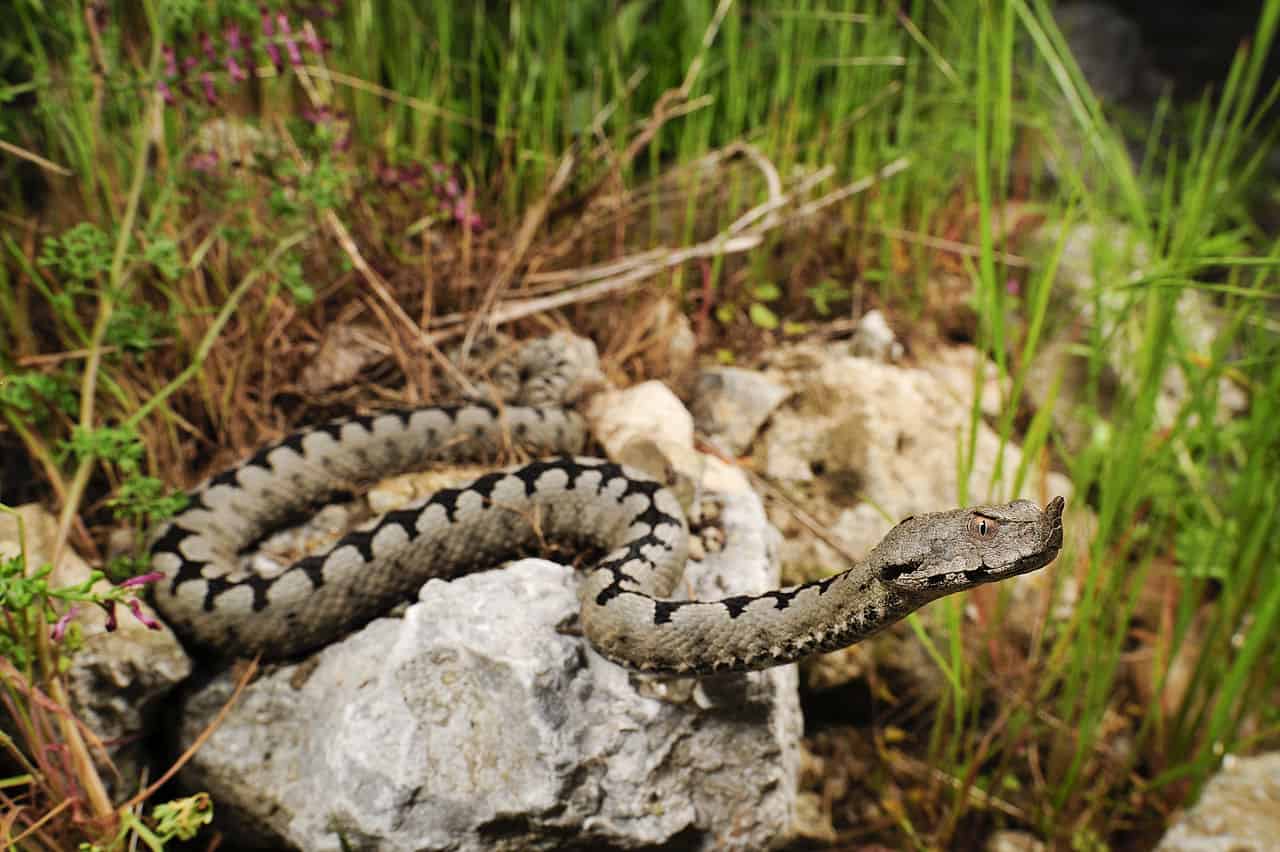
Location: southeast Europe. Italy and Austria westernmost points.
Widely considered to be the most dangerous snake in Europe. Whether they top the tables is debatable, but the nose-horned viper (Vipera ammodytes) is undoubtedly one piece of Greek culture you’ll want to stay well away from.
Nose-horned vipers are a species of southeast Europe, including Greece, Albania, Croatia, Bosnia, etc. Their venom scores 0.48mg on the LD50 toxicity scale, defeating the death adder, timber rattlesnake and even king cobra. It’s only their smaller venom yield of 15-45mg which stops them from being a true nightmare.
Nose-horned vipers are a medium snake at 50-70cm, with a record of 110cm, and are named for a fleshy horn above their snout. They mainly inhabit rocky regions, and have a rocky grey colour to match, with a fused zigzag down their spine. Their bite can unleash symptoms such as vomiting, fever, nausea, and dizziness. In Greece, they’re the species responsible for the most snakebite hospitalisations per year.
Nose-horned vipers can kill not just children, but fully grown men. 2 deaths were recorded in the 1990s, both soldiers at Velebit Mountain near Zadar in south Croatia. The first was bitten on the neck while dozing in a sleeping bag, while the second was bitten under the arm while relaxing against a tree at noon.
Nose-horned vipers have 13mm fangs, and their venom contains multiple toxin classes, including neurotoxins, haemotoxins and anticoagulants. The saving grace, the only thing that keeps Greek civilisation up and running, is that Vipera ammodytes is lethargic and non-aggressive, only biting when pushed.
| 2 | European catsnake |
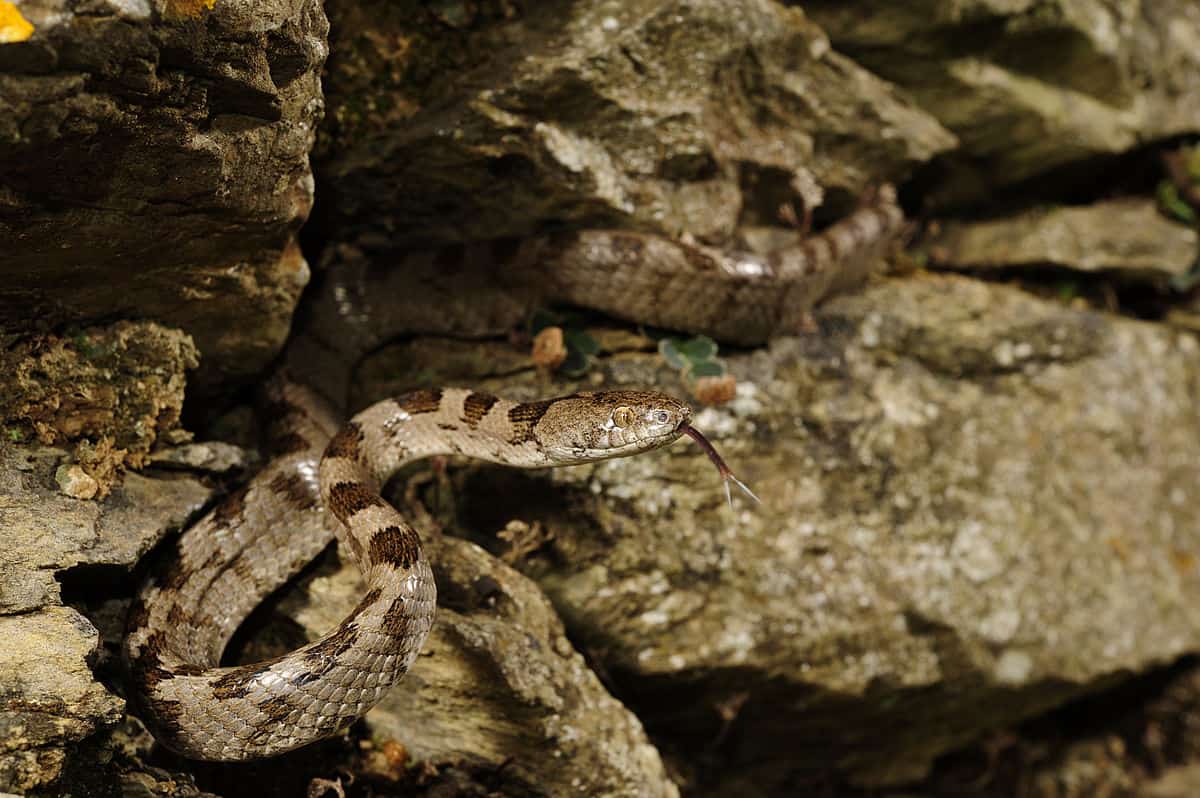
Location: from Italy to Israel.
A common reptile-eating snake, which is usually about 60cm long, with a record of 130cm. The European catsnake (Telescopus fallax) is found in southeast Europe, mainly in rocky areas, dry sunny slopes and open oak forests, and also railways. On a fearful note for passengers, this snake is part of a growing club: serpents mistakenly believed to be venomless.
The European catsnake was originally filed as harmless because of its venom delivery system. Instead of the typical rapidly injected venom from its front fangs, it secretes a much weaker venom from its rear fangs. These fangs are lined with furrows so that when the snake chews its prey, the venom runs into the bite wound like a miniature fountain. It’s slow and cumbersome, but enough to subdue the geckos and lizards it eats, one of which is Erhard’s wall lizard.
The European catsnake has barely any chance of hurting a human, but could do harm if left to chew for several minutes. European catsnakes often try to bite when picked up, even attempting to swallow your finger. A cocky youth could believe the snake to be harmless and leave it attached out of pure bravado, as it continues to bite, before unexpectedly swaying over. It’s best not to be the first person to find out.
| 3 | Adder |
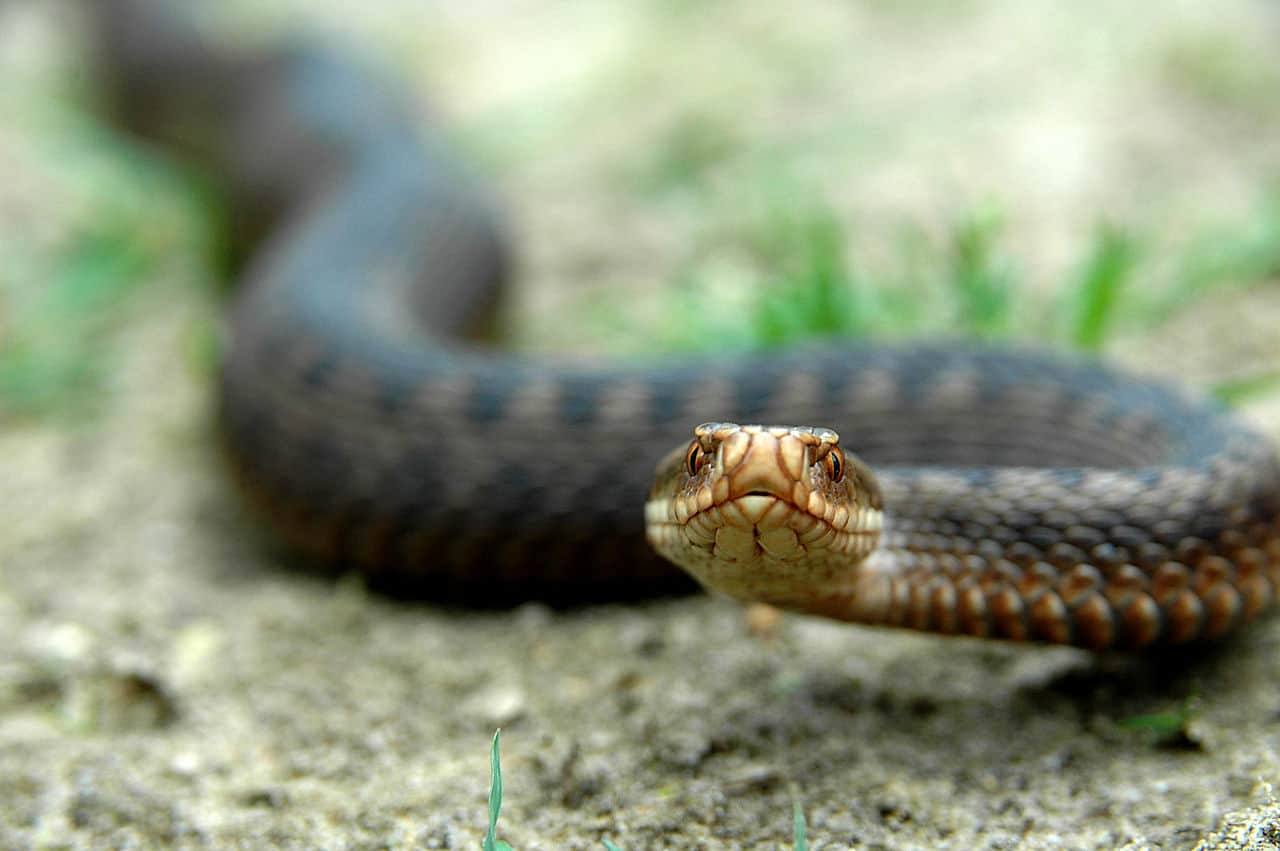
Location: most of Europe, except the far south.
Famous as the UK’s only dangerously venomous snake, but the adder (Vipera berus) occupies a massive range in Eurasia, reaching as far east as Kazahkstan. The only major European countries it skips are Spain and Portugal, and it has powerful colonies in Scandinavia.
The adder has the highest LD50 toxicity rating in Europe, at 0.11mg. This is counterbalanced by a small venom yield, at a maximum of just 18mg per bite. Nevertheless, this famous snake is fully capable of dealing out death. The last fatal case in Britain was in 1975, but a Yorkshire man was left extremely injured after a bite in 2014. From 1876 to 1975, there were 14 fatalities in Britain.
Norway has approximately 200-500 adder bites per year, and every ten years one will prove fatal. Certain UK forests have signs outside warning of the writhing adders within – the UK statistics are 100 bites per year. The standard symptoms are tingling and swelling, but in severe cases the entire arm can swell up, and this can spread to the trunk. Luckily, adders are not particularly aggressive.
Many bites happen after walkers accidentally step on them. One happened in 2016, when 13 year old Macey Roberts was running along the sand dunes of Pwllheli beach in Wales. He felt a sharp pain in his foot and thought that he’d been stung by a needle, but his sister investigated and soon found a resting adder. Soon he was “virtually unconscious”, as they dragged him to a nearby golf club for assistance. Adders are fairly short, at 50-60cm, with a record of 104cm from Scandinavia.
| 4 | Meadow viper |
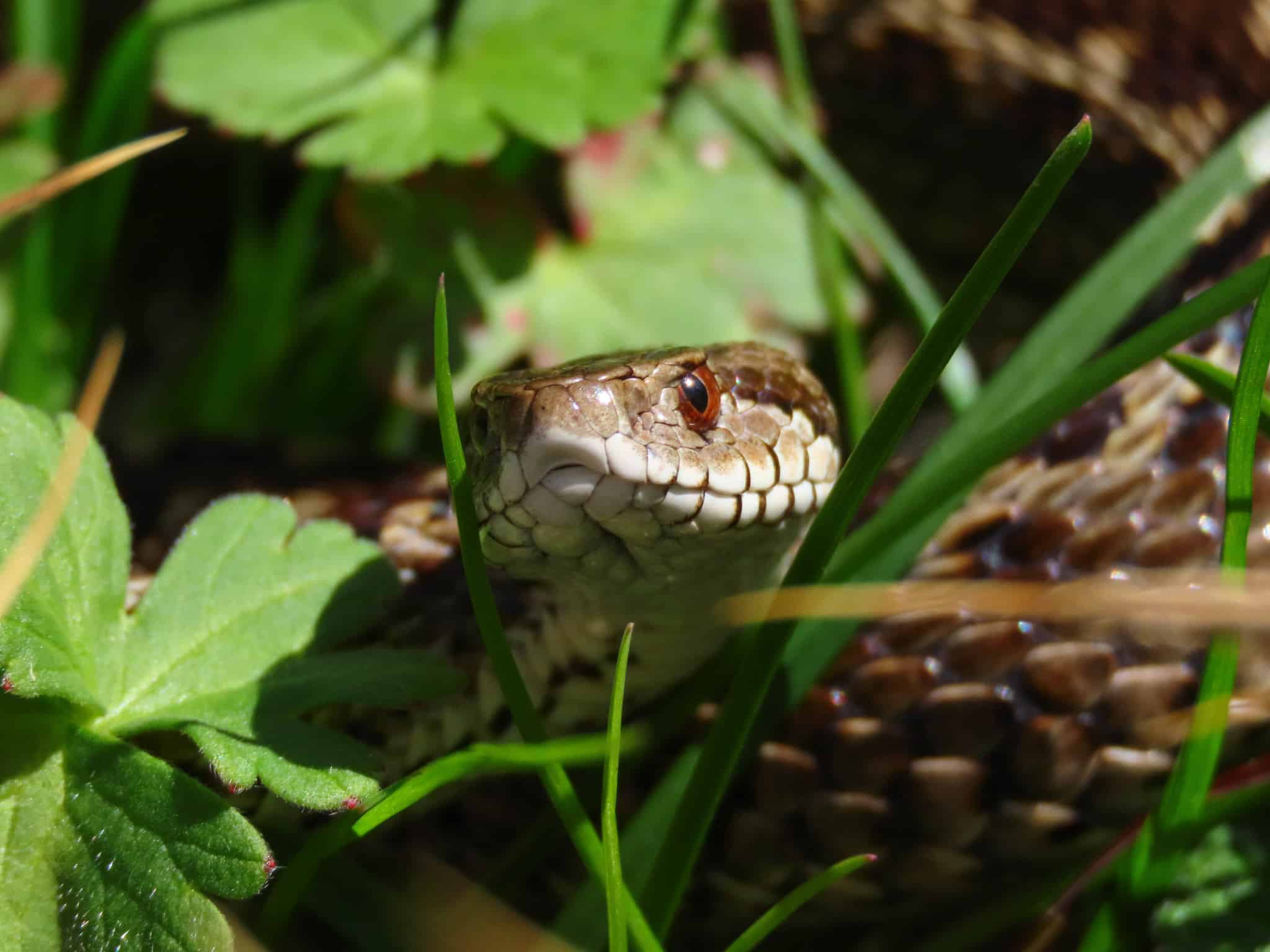
Location: France, Italy, eastern Europe.
Anyone bitten by this snake would be incredibly unlucky, as it’s now one of Europe’s most endangered snakes. The meadow viper (Vipera ursinii) is Europe’s smallest viper, averaging at 30-40cm, and pushing to 66cm in massive anomalies. It exists only in small pockets of undisturbed countryside, which are now fragmented and growing ever smaller.
Though small, the meadow viper has a venom which shouldn’t be underestimated. On the con side, its venom yield is just 1-4mg, but its LD50 potency rating is a respectable 2.17mg. A study on 64 bites found that 45 successfully injected venom, and most symptoms were mild, like swelling and numbness. But 13% of victims suffered from massive limb edema (swelling), and 6% suffered from surface level skin tissue necrosis. Recovery time varied from 12 hours to 2 weeks.
That said, there are no confirmed deaths on record for this species. Views differ on the meadow viper’s temperament. Some say that it’s twitchy and erratic and will randomly bite, while according to others, it’s calm and docile and only strikes when pressured.
| 5 | Dice snake |
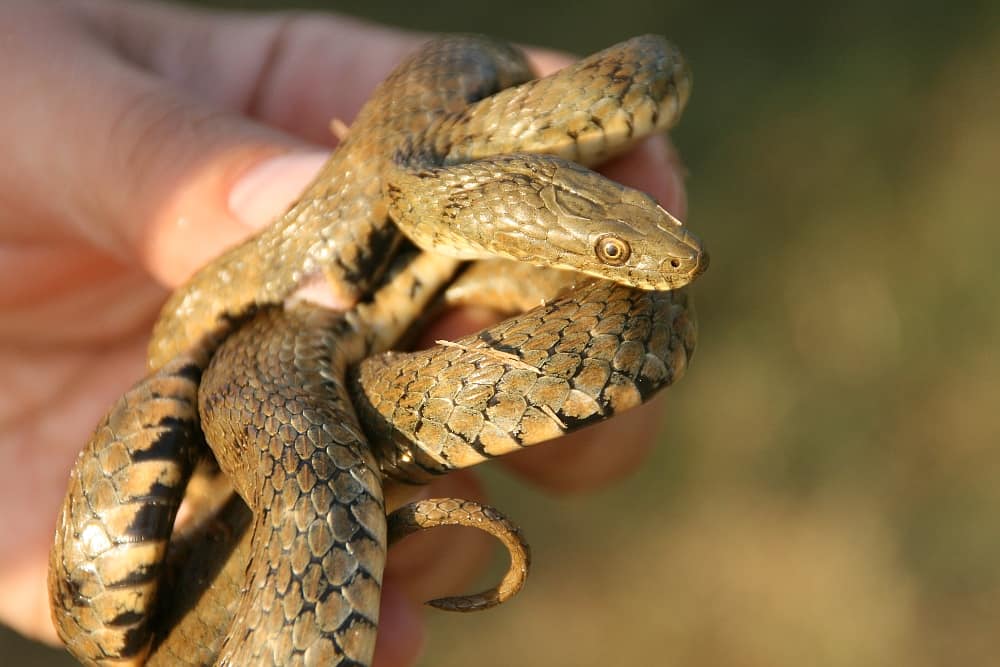
Location: central and eastern Europe, Germany and Switzerland eastwards.
The water-loving dice snake uses the same strategies as the European catsnake. It lacks front fang venom, and is instead a rear fanger which chews in a weak venom manually. Consequently, there are no human deaths on record for this semi-aquatic serpent, but you’d be well advised not to let it chew your finger out of pure generosity while you have a riverside picnic.
The dice snake (Natrix tessellata) reaches a record of 130cm, and has the claim to fame of being extremely common. In certain lakes, they can swell to thousand upon thousands. The River Danube is one of their hotspots, flowing through Austria, Hungary and Serbia. This species is a powerful swimmer, and its venom comes in use when it seizes fish with its jaws, hoping to subdue its prey before beginning the tricky process of rearranging before swallowing.
Dice snakes have an LD50 score of 25mg in mice (although they mainly prey on fish), and their venom is mostly neurotoxic. It possesses ingredients such as arginine esterase, acid phosphatase and alkaline phosphatase, alongside a helping of proteases, protein-digesting enzymes which we all produce in our stomachs. These are designed to dissolve a bigger opening for the more dangerous toxins. The venom is produced by a Duvorney’s gland, which is only found in rear-fanged species.
| 6 | Baskian viper |
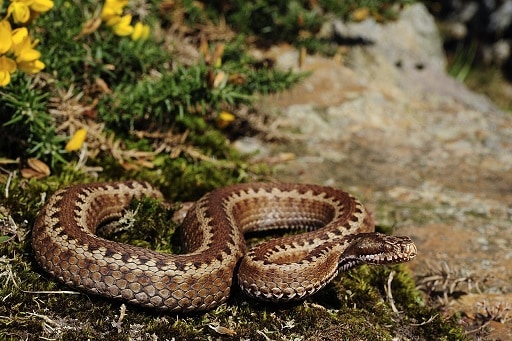
Location: Spain, Portugal, France.
A less famous viper of Europe, which inhabits the northern quarter of Spain, extreme northern Portugal, and extreme southwest France. The Baskian viper (Vipera seonanei) is fully equipped with front fang venom, which it injects in a blink and you’ll miss it strike.
The precise lethality of this snake varies by region. There’s two subspecies, including one in the Cantabrian mountains of Spain’s northwest, which has a more severe LD50 rating of 6.9-9.9mg. In the rest of the range, the LD50 score is a mere 23.1-23.6mg.
Either way, this species has a much gentler venom than the adder. Spain is essentially divided into three viper regions: the Lataste’s viper in the lower two thirds, the asp viper in the northeast, and the Baskian viper in the northwest (with slight overlaps). Residents of Cantabria are probably thanking their lucky stars that they’ve got the least severe of the three. The precise toxins in the venom are barely researched, just the deadliness of the overall mixture. This species has no confirmed deaths on record.
Baskian vipers reach a maximum of 75cm in length, and its adults mostly eat mammals. It’s noticeably different in appearance to the Lataste’s viper, as the latter has a big, blotchy black zigzag down its spine like a child using a paintbrush, while Vipera seoanei has more ordered and intricate patterns.
| 7 | Montpellier snake |
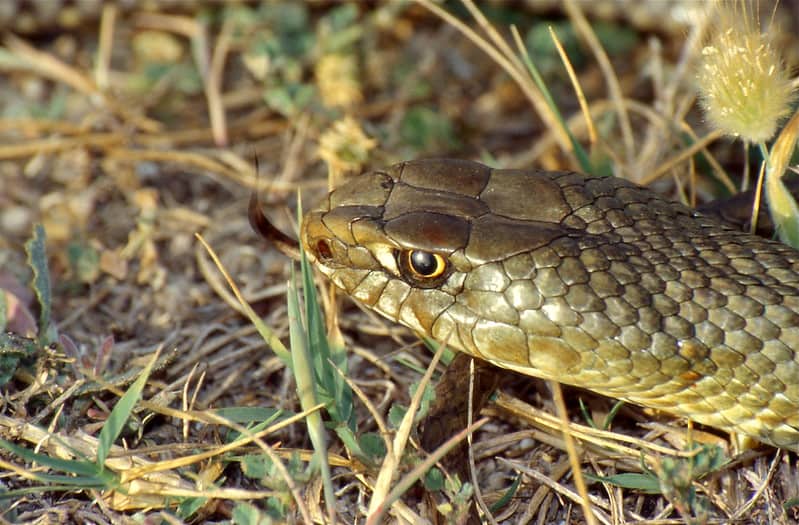
Location: France, Spain, Portugal, North Africa.
Spain’s longest snake, pushing to an all-time record of 216.2cm in the largest, oldest individuals. The Montpellier snake is a rear-fanged species, but not to be underestimated. Its venom, chewed in manually, can kill a small mammal in less than 3 minutes. In mice, the venom works by creating severe lung haemorrhages. It causes leakages of blood into the pulmonary alveoli, the millions of tiny spaces in the lungs where oxygen is exchanged for carbon dioxide.
Luckily for humans, most Montpellier snake bites are dry, and they have a small mouth that makes biting difficult. But if venom does make contact, it can be serious, with terrifying neurological symptoms. A French teenager once decided to poke his finger deep into a Montpellier snake’s mouth for fun. Weeks later, he was the subject of a scientific study, having experienced drooping eyelids and oculomotor paralysis (haywire eye muscles). It took 6 days for him to recover.
There are rumours of a Libyan who died from this snake sometime before 1987, although no confirmed deaths have occurred in Europe. The Montpellier snake is also an extremely fast, active snake, which can raise its upper body and hiss loudly, or disappear extremely rapidly over a stone wall. They’re not fussy about their habitats, and can pop up virtually anywhere.
| 8 | Asp viper |
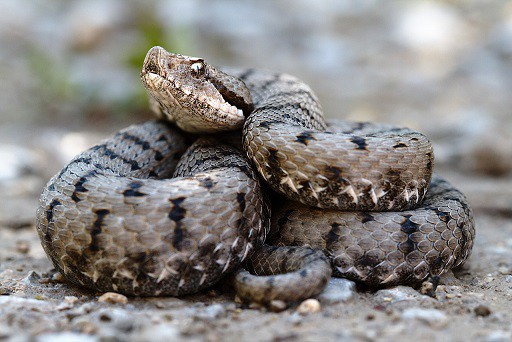
Location: Italy, Switzerland, the lower 80% of France.
This is France’s signature viper, a countryside dweller which particularly loves hedges and meadows, and has gradually become endangered. Most older French people who generically say “viper” are thinking of this species, although the adder rules the northern 20% of the country, with asp vipers controlling the southern 80%.
On paper, the asp viper has a significantly gentler bite than its cousins. The LD50 score is only 1mg versus 0.11mg for the adder, and the venom yield is 9-10mg versus 10-18mg. Yet the asp viper seems to cause more deaths, averaging at 1 per year in its French heartlands. By raw death toll, this makes it Europe’s deadliest snake.
This 60-65cm snake (maximum 82cm) produces a rich elixir of snake danger, with some weird effects, including temporary blindness caused by the venom bombarding eye cells. Scientists have much to learn, but the venom seems to be more neurotoxic than the adder further north. Asp vipers can cause drooping eyelids, vertigo, difficulty swallowing, and drowsiness. These brain signal problems usually kick in within 4-12 hours.
Despite its habitats gradually retreating in the face of modernised mechanised agriculture, the asp viper still manages to evenomate several hundred Frenchmen per year.
| 9 | False smooth snake |
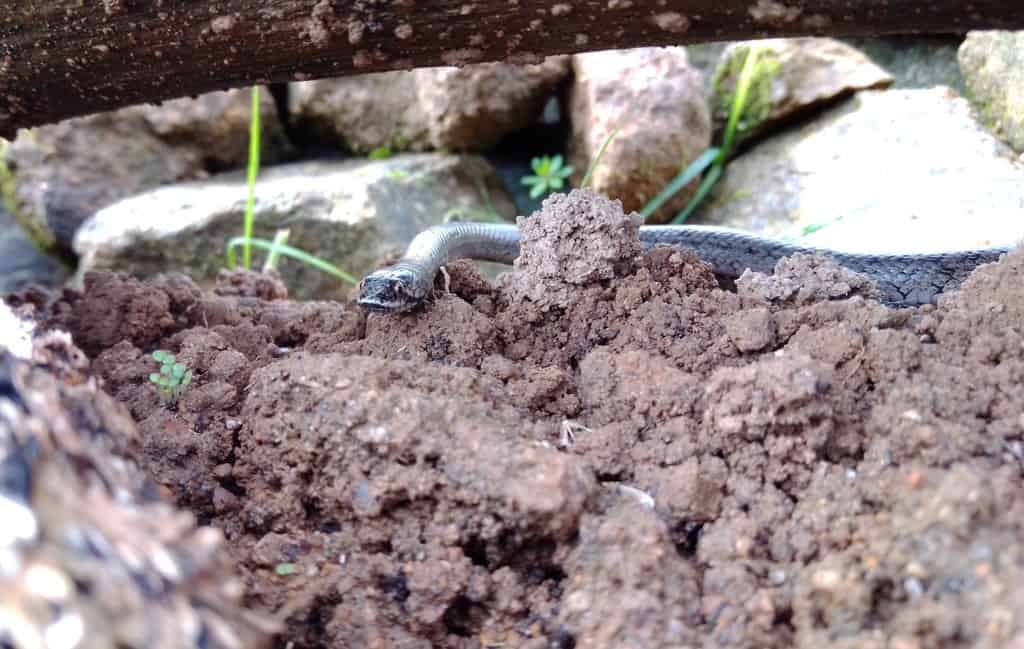
Location: Spain, Portugal.
A slow and patient snake, but a smart snake. This 40-60cm serpent (max 59.8cm) is semi-underground dwelling, often hangs out in animal burrows, and moves as little as 5 metres per day. While the Montpellier snake zooms around Spain like a madman, getting picked off by short-toed eagles from above, the false smooth snake smiles and pulls its head back into its shadowy tunnel sanctuaries.
Its venom is similarly patient. This is a rear-fanged snake which forcibly chews its venom into prey, 50% of which is the blue-coloured Iberian slow worm. Its venom so weak that a false smooth snake can take 70 minutes to catch, subdue and swallow one reptile. There’s no rush in its cosy soil lairs; the false smooth can easily afford to take its time. But there’s a slight chance of danger from this venomous snake, as they’re more bitey than the dice snake, for instance. Despite being slow and gentle, false smooth snakes often flip out when picked up.
Their bite has never killed, but can cause throbbing and redness for several hours afterwards. Again, their rear fangs are grooved, to allow a mini stream of venom to flow into the open bite wound.
| 10 | Lataste’s viper |
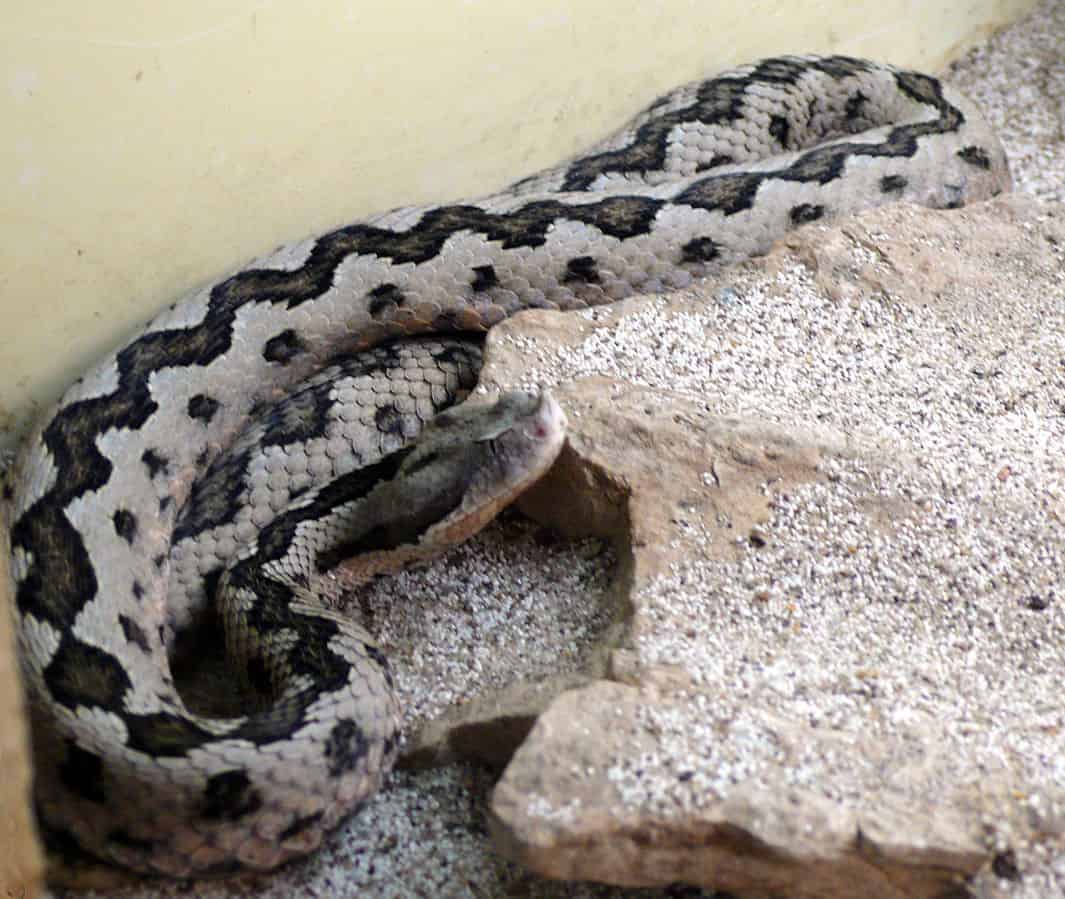
Location: Spain, Portugal. Likes rocky slopes with shrubs.
This is Spain and Portugal’s main viper, occupying all but the top portion of Spain (Baskian viper country). The Lataste’s viper (Vipera latastei) measures 30-60cm, with a maximum of 75cm, and has vertical pupils which clearly demonstrate that it means business. Like the nose-horned viper, they have a grey colour in order to blend with the grey rocky slopes they favour.
Lataste’s viper is more studied than some European vipers, and has two main toxin classes. The first is phospholipase A2, a cytotoxic family, which attacks cells and can cause blackening necrosis spreading all the way up the arm. The second is snake venom serine proteinase (SVSP), which is responsible for blood clotting chaos, either pro or anti.
Officially, Lataste’s viper venom is much weaker than the adder or asp viper, scoring just 7-20mg on the LD50 scale, but many Spanish villagers have suffered rotting skin and agony after absentmindedly bending over to pick up garden items. Others escape with minor throbbing and redness, but it’s always a game of chance.
A unique feature is that Lataste’s vipers have fragile fangs which often break off in the victim’s arm. As they age, their venom composition changes. Youths produce far more matrix metalloproteinases, which cleave bonds in amino acids and break down proteins in the skin en masse.
